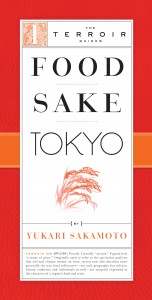Interview with JET alumna/’Food Sake Tokyo’ author Yukari Sakamoto
 By JQ magazine’s Justin Tedaldi (CIR Kobe-shi, 2001-02) for Examiner.com. Visit his NY Japanese Culture page here to subscribe for free alerts on newly published stories.
By JQ magazine’s Justin Tedaldi (CIR Kobe-shi, 2001-02) for Examiner.com. Visit his NY Japanese Culture page here to subscribe for free alerts on newly published stories.
Tokyo-born and American-raised JET alumna Yukari Sakamoto (Chiba-ken, 1989-1990) is a professional chef, sommelier, and writer who has spent much of her life in both the U.S. and Japan. Released earlier this year, her debut book Food Sake Tokyo is the ideal guide for indulging in the best of Tokyo dining and drinking, whether you’re a first-time visitor or a Japanophile foodie keen on discovering new favorites.
How were you approached to write this book as part of the Terroir Guides series?
I contribute to Food & Wine magazine and my travel editor there at the time, Salma Abdelnour, told me about the publisher The Little Bookroom. She praised their travel guides and thought my book would find a good home there. My agent, Lisa Ekus, sent my proposal to The Little Bookroom, and the publisher, Angela Hederman, embraced it immediately. The Little Bookroom has a series of foodie travel guides called the Terroir Guides, and my book was a perfect fit—like Cinderella’s glass slipper. I have heard how difficult it is to find a publisher who will accept a book proposal, and I am blessed to have found the perfect home.
In the introduction to your book, you write that the popularity of the Slow Food movement has created a renewed appreciation for kyodo ryori, or local foods. How long has this movement been going on, and what started it?
The Slow Food movement has been popular for a long time. What has been extremely popular in the last few years are “antenna shops.” These regional shops represent prefectures from around Japan that feature local produce, beverages, and foods. For example, the Okinawa Washita shop in Ginza has a basement filled with awamori (the local shochu), including rare brands hard to find outside of Okinawa. The first floor has tropical fruits and vegetables and local specialties like shimadofu, a dense tofu, and shikuwasa, a citrus juice. I cannot say for sure what started it, but there are several contributing factors. Food safety scares and mislabeling of imported product have encouraged more consumption of local products. Popular food and travel programs promote regional specialties. And, there are an increasing number of ambassadors, like the governor of Miyazaki [Prefecture], Hideo Higashikokubaru, who enthusiastically promote Miyazaki products like wagyu, mangoes, etc. I am always impressed at the number of customers at antenna shops. I often go out my way to shop at antenna shops to pick up rare shochu, hard to find miso, or pickles.
There are more than 100,000 restaurants in Tokyo. How did you pare it down to the ones listed in the book?
First of all, I focused on restaurants that represented a particular cuisine. And then I narrowed down the list based on geography, leaning toward easy to find restaurants, or those included in one of the areas covered by the book. I have lived in Tokyo for eight years and ate out a lot while there. Tokyo is a great dining city, especially for solo diners.
Read the complete interview here.


Comments are closed.